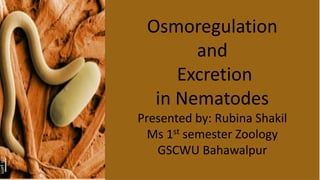
Nematodes.
- 1. s Osmoregulation and Excretion in Nematodes Presented by: Rubina Shakil Ms 1st semester Zoology GSCWU Bahawalpur
- 2. Introduction of Nematodes The nematodes or roundworms constitute the phylum Nematoda (also called Nemathelminths) with plant-parasitic nematodes being known as eelworms. They are a diverse animal phylum inhabiting a broad range of environments. It is estimated that there may be over 1 million species of nematode.
- 3. • Free-living or parasitic • Most very small < 2mm, some 1m long • Abundant (100 in a cupful of soil) >20,000 named species, many others undescribed • Radial symmetry - cylindrical body • Pseudocoelomate - false body cavity • Tough cuticle must be shed to grow • Has cephalization
- 4. Size : Human and Animal parasites are big and visible to the naked eyes • Ascaris lumbricoides …………………...30 cm • Dracunculus medinensis……………….1m • Placentonema gigantissimma ………...8 m (longest) • Free-living nematodes microscopic • Greeffiella minutum…………………….82 µm (smallest)
- 5. Prescence in environment: Nematodes have successfully adapted to nearly every ecosystem: • from marine (salt) to fresh water, • soils, from the polar regions to the tropics, • as well as the highest to the lowest of elevations (including mountains). They are ubiquitous in • freshwater, • marine, and • terrestrial environments, • are found in locations as diverse as • mountains, • deserts, • and oceanic trenches • They live in host animals and plants as parasites.
- 7. Osmoregulation and Excretion: Excretory glands and canals thought to be involved in: • Osmoregulation • Ionic regulation • Excretion of waste metabolites • Ammonia secreted through body wall.
- 8. Introduction • Excretory system is one of the most simplest system of nematodes. • Waste is turned into ammonia and is excreted through the body. • The major nitrogenous waste product is ammonia. • The excretory products of nematodes are numerous like amino acid , peptides, uric acid , fatty acid • The excretory pore is located in the anterior mid ventral line close to the nerve ring. • Parasitic worms tend to have a glandular process to excrete. • Nonparasitic worms tend to have a much more tubular method of releasing their salty waste.
- 9. Components of Excretory System Four different cell types: • A pair of gland cell • One canal cell (Excretory cell) • One duct cell • One pore cell
- 10. Phylum Nematoda divided into two classes based on the type of excretory system: 1.Glandular Type : •Present in class Adenophorea 2.Tubular Type •Present in class Secernentea
- 11. Canalicular or Tubular type • Present in Class Secernentea Basically H– shaped, • variable Two main longitudinal excretory ducts running in lateral hypodermal chords Joined in esophageal region by a transverse duct • A terminal duct arises and opens on ventral side the excretory pore
- 12. Glandular type Present in Class Adenophorea Single (Renette) cell leads to an excretory duct and opens outside through pore
- 13. Nitrogenous waste is excreted in the form of ammonia through the body wall, and is not associated with any specific organs. However, the structures for excreting salt to maintain osmoregulation are typically more complex. Renette cell: The renette cell is a glandular type of secretory-excretory organ. It consists of a single gland cell situated near the base of the esophagus. From the cell there extends anteriorly a renette duct, which usually swells into an ampulla close to the ventral pore.
- 14. Structure of Renette Cells: In many marine nematodes, one or two unicellular 'renette glands' excrete salt through a pore on the underside of the animal, close to the pharynx. In most other nematodes, these specialized cells have been replaced by an organ consisting of two parallel ducts connected by a single transverse duct. This transverse duct opens into a common canal that runs to the excretory pore.
- 16. Function of Renette Cells: Specialized cells for excretion, which are known as renette cells and are unique to the phylum, remove nitrogen-laden wastes. They have the potential to be important to processes occurring in • lakes, • streams, and • other freshwater habitats. The waste leaves the body.
- 17. Caudal Glands: Both the renette cell and caudal glands are common in adenophorean nematodes. Aquatic nematodes with renette and caudal glands share the property of secreting an adhesive material that allows for anchorage in a current of water; currently, this secretory function is attributed only to the caudal glands.
- 18. Alternate Cellular Means of Excretion There are certain cells in the nematode body which help in excretion: • Hypodermal glands: They enhances the efficiency of excretion by functioning throughout the length of the body. • Prerectum: It is the connection between intestine and rectum. • Coelomocytes : These are the cells situated in the body cavity.
- 19. Significance of Excretory System Maintaining osmoregulation. • Regulating turgor pressure in the body cavity. • Removes foreign particle. • In female of citrus nematode Tylenchulus semipenetrans, excretory pore is located posteriorly and it is responsible for the secretion of the gelatinous matrix surrounding the eggs. • Ecdysis is accompanied by the synthesis of the enzyme leucine aminopeptidase in the excretory gland and its release via the excretory duct into the space between the two cuticles in Phocanema
- 20. Conclusion: In nematodes, specialized excretory systems are not well developed. Nitrogenous wastes may be lost by diffusion through the entire body or into the pseudocoelom (body cavity), where they are removed by specialized cells. Regulation of water and salt content of the body is achieved by renette glands, present under the pharynx in marine nematodes.